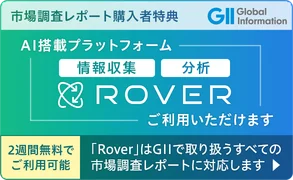
|
市場調査レポート
商品コード
1620281
アジア太平洋地域の低軌道(LEO)からの衛星D2D(Direct-to-Device)市場に成長機会、2029年までの予測Growth Opportunities in Satellite Direct-to-Device from Low Earth Orbit Market, Asia-Pacific, Forecast to 2029 |
||||||
|
|||||||
| アジア太平洋地域の低軌道(LEO)からの衛星D2D(Direct-to-Device)市場に成長機会、2029年までの予測 |
|
出版日: 2024年12月05日
発行: Frost & Sullivan
ページ情報: 英文 52 Pages
納期: 即日から翌営業日
|
全表示
- 概要
- 目次
市場が新たな次元に突入し、収益化の可能性が変革的成長を遂げる
アジア太平洋(APAC)の低軌道(LEO)からの衛星D2D(Direct-to-Device)収益は、2024年の10万米ドルから2029年には6億4,680万米ドルに、28.6%の複合年間成長率で増加します(2025年~2029年)。接続サービスが主に衛星D2Dの収益を牽引します。APACは、その地域性と、重要インフラに広範な損害を与えうる自然災害に対する脆弱性を併せ持つことから、重要な市場となります。広大な国土と何千もの島を持つこの地域では、人口の約55%がインターネットに接続できないままです。
LEOからの衛星D2Dは、衛星接続の競合レベルを高め、基本的なサービスの手頃な価格に関する問題に対処します。地上キャリア依存のモバイルサービスのバックアップと補完という2つの可能性が検討されています。消費者や企業がどこにいても、特に緊急時に確実に接続できることは、リスクの軽減、消費者の不便の軽減、地域の企業のダウンタイムの軽減という形で利益をもたらします。
衛星プロバイダーは、その多くが移動体通信事業者と提携しており、地上波のアプローチや慣行を破壊しようとしています。しかし、収益化とビジネスケースの正当化は課題です。多くのトライアルが行われるだろうが、2030年までに多くの商業的に実行可能なサービスが大衆市場に提供される可能性は低いです。LEOのネットワークやデバイスからさまざまな衛星D2Dへの相互運用性とスケーラビリティを確保するには、周波数と規制政策、エコシステム開発、標準化努力の世界な調和が不可欠となります。オープンなソリューションに取り組む強力なパートナーシップは、より大きな成長の可能性を秘めています。
目次
衛星D2D分野の変革
- なぜ成長が難しくなっているのか?
- The Strategic Imperative 8(TM)
- 衛星D2D業界における3大戦略のインパクト
エコシステム
- 分析範囲
- セグメンテーション
- 競合環境
- 主な競合企業とプロファイル
成長要因
- 成長指標
- 成長促進要因
- 成長抑制要因
- 予測に関する考察
- 収益予測
- 製品別の収益予測
- 収益予測分析
- 価格動向
- 市場成長の実現要因:商業および規制
- 市場成長の実現要因:技術
成長要因:SOSサービス
- 成長指標
- 収益予測
- 予測分析
成長ジェネレーター:接続サービス
- 成長指標
- 収益予測
- 予測分析
成長ジェネレーター:バックホールサービス
- 成長指標
- 収益予測
- 予測分析
成長機会領域
- 成長機会1:衛星プロバイダー向けのLEOからの衛星ソリューション
- 成長機会2:移動体通信事業者と企業向けの衛星ベースのホールセール・バックホールサービス
- 成長機会3:モバイル事業者の収益化機会の拡大
付録と次のステップ
- 成長機会のメリットと影響
- 次のステップ
- 別紙リスト
- 免責事項
Monetization Potential is Experiencing Transformational Growth as the Market Enters a New Dimension
The satellite direct-to-device (D2D) from low Earth orbit (LEO) revenue in Asia-Pacific (APAC) will increase from $0.1 million in 2024 to $646.8 million in 2029 at a 28.6% compound annual growth rate (2025-2029). Connectivity services will mainly drive satellite D2D revenue. APAC will be a key market due to its combination of geography and vulnerability to natural disasters that can cause widespread damage to critical infrastructure. In this region, which has countries with large land masses and thousands of islands, approximately 55% of the population remains without internet connectivity.
Satellite D2D from LEO will increase the competition level for satellite connectivity and address issues related to the affordability of basic services. Two possibilities are being investigated: as a backup and as a complementary to terrestrial carrier-dependent mobile services. The certainty of connecting consumers and enterprises wherever they are, especially in an emergency, will bring benefits in the form of reduced risks, less inconvenience for consumers, and less downtime for enterprises in the region.
Satellite providers, many in partnerships with mobile operators, are out to disrupt terrestrial approaches and practices. However, monetization and business case justification will be challenging. While there will be many trials, it is unlikely that many commercially viable services will serve the mass market before 2030. Global harmonization of spectrum and regulatory policy, ecosystem development, and standardization efforts will be crucial in ensuring interoperability and scalability across different satellite D2D from LEO networks and devices. Strong partnerships working on open solutions will have greater growth potential.
Table of Contents
Transformation in the Satellite Direct-to-device Sector
- Why Is It Increasingly Difficult to Grow?
- The Strategic Imperative 8™
- The Impact of the Top 3 Strategic Imperatives on the Satellite Direct-to-device Industry
Ecosystem
- Scope of Analysis
- Segmentation
- Competitive Environment
- Key Competitors and Profiles
Growth Generator
- Growth Metrics
- Growth Drivers
- Growth Restraints
- Forecast Considerations
- Revenue Forecast
- Revenue Forecast by Product
- Revenue Forecast Analysis
- Pricing Trends
- Enablers of Market Growth: Commercial and Regulatory
- Enablers of Market Growth: Technical
Growth Generator: SOS Services
- Growth Metrics
- Revenue Forecast
- Forecast Analysis
Growth Generator: Connectivity Services
- Growth Metrics
- Revenue Forecast
- Forecast Analysis
Growth Generator: Backhaul Services
- Growth Metrics
- Revenue Forecast
- Forecast Analysis
Growth Opportunity Universe
- Growth Opportunity 1: Satellite Solutions from LEO for Satellite Providers
- Growth Opportunity 2: Satellite-based Wholesale Backhaul Services for Mobile Operators and Enterprises
- Growth Opportunity 3: Broadening Monetization Opportunities for Mobile Operators
Appendix & Next Steps
- Benefits and Impacts of Growth Opportunities
- Next Steps
- List of Exhibits
- Legal Disclaimer


